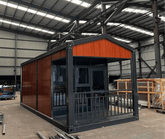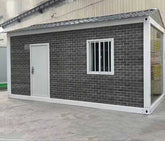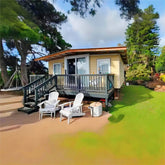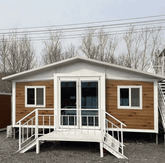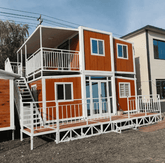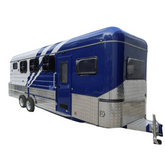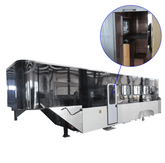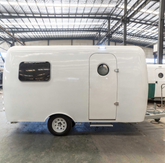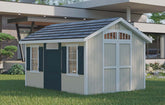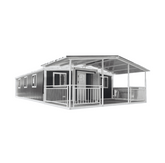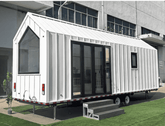Tiny House Living on the Rise with New Laws
Tiny homes are finding more acceptance around the U.S. thanks to new legal changes. Dozens of states now allow accessory dwelling units (ADUs) or “casitas” on residential lots, which makes building a tiny home much easier. For example, in 2024 Colorado passed a law requiring cities to permit one ADU on any single-family lot and banning restrictive local bans on such units. Officials said this change “empowers homeowners” to add small houses (like backyard cottages) without costly paperwork, creating more affordable housing and extra income. In fact, at least 14 states have now broadly legalized ADUs so homeowners can build and rent out tiny second units on their property. These state laws generally require only a simple permit and often waive extra fees or parking rules.
The new laws often include tiny houses on wheels too. In New York State, for instance, the building code was updated with “Appendix Q” so that tiny homes are officially treated as legal ADUs on any lot with a house. Portland, Oregon has likewise loosened rules: homeowners there can now keep one trailer tiny home or RV on their lot in place of a traditional ADU, as long as it meets safety standards. Even bigger moves are happening: Oregon’s legislature passed a 2023 law (SB 1013) letting counties approve one utility-connected mobile tiny home per rural lot, and Portland made this allowed for every city lot. Nearby Washington state is proposing a bill (SB 5332) to let one mobile tiny home be added to any home lot in an urban area. All these examples show a trend: more places view tiny homes as a flexible, affordable housing choice.
Tiny-House Friendly Communities and Cities
Many communities now encourage tiny-house living rather than block it. For example, Spur, Texas bills itself as the first “tiny-home-friendly” town in America. Since 2014, Spur has allowed houses under 900 sq ft by right on any lot (no minimum size required), making it simple to move or build a tiny home there. Across the country, other small towns have followed suit. On Florida’s Space Coast, the city of Rockledge created special “pocket neighborhood” zones where both tiny homes on wheels and tiny homes on foundations are allowed. In North Carolina, the town of Brevard even partnered with local groups to write a guide showing how to build tiny houses up to 800 sq ft on a foundation under city rules. These efforts mean residents can have a legal tiny home in their backyard or in a small cluster of mini-houses.
Large states now have dozens of tiny-house communities too. Texas and Colorado lead the way: according to recent rankings, Texas hosts about 16 tiny home communities and Colorado about 20. (Virginia is another top state with 14+ tiny-home villages.) Many of these neighborhoods feature small homes clustered around parks or shared gardens. In Oregon, Portland runs regular tours of new tiny-ADU projects. These communities create built-in support networks for buyers – neighbors who share experience and resources. In short, you’re not alone: tiny-home-friendly neighborhoods are growing in many regions.
Legal and Practical Benefits
Building or buying a tiny home under the new rules brings big benefits. Cost savings are perhaps the biggest. Tiny houses use far less material and energy than regular homes. This means lower construction costs, smaller utility bills, and often lower taxes. For instance, modern tiny homes with full bathrooms and kitchens can sell for as little as $10,000 to $200,000 – roughly one tenth the cost of a typical backyard ADU (which might run $250,000–$500,000). Owners report much less debt and more disposable income. “Tiny homes can enable significant savings on typical homeowner costs” like heating, cooling, maintenance, and taxes. People also love the flexibility: many tiny homes are on trailers or small foundations, so they can be moved or sited in diverse places. It’s easier to build on a tight timeline (some tiny homes can be completed in weeks instead of years), and you can upgrade or relocate as needs change.
Tiny homes also allow creative living solutions. Homeowners are adding them as backyard “granny flats” to house aging parents, college-age children, or renters who provide extra income. Because many ADU laws now let the tiny dwelling be rented separately, a family can easily manage two units on one property. In short, laws that support ADUs and tiny homes give families more housing options for relatives, friends, or even Airbnb guests, while earning rent. Experts note that these changes can “provide flexible, affordable, and sustainable housing options” for a wide range of households.
Another key benefit is community vitality. Zoning changes that allow tiny homes often go hand-in-hand with broader housing reforms. For example, Portland and Seattle have passed several housing bills recently – some call 2023–2024 “the year of housing” – which relax rules on multiple dwelling units per lot and minimize red tape. By allowing small homes on more lots, cities help address housing shortages. Tiny homes can be part of a gentle density strategy: adding a few small homes per block increases the housing supply without building high-rises or changing neighborhood character drastically. In Washington state’s case, legislators are specifically trying to legalize a new category of “mobile dwelling units” on private lots, aiming to give people quick, affordable places to live in tight housing markets.
Where Tiny Homes Are Legal
Although rules vary, many people can find a spot to live tiny without breaking the law. Some general points:
- Backyard ADUs: In most parts of California, Oregon, Texas, Colorado, Florida, and several Northeast states, building a small cottage or detached unit on your own land is now explicitly allowed by state or local law. Check if your area has ADU rules; many cities publish simple guides or checklists (like Brevard’s tiny home guide).
- Tiny homes on foundations: Many places simply treat tiny houses on foundations as small regular homes. If local building codes use the 2018+ International Residential Code, they often include “Appendix Q”, which sets standards for houses under 400 sq ft. New York and Oregon adopted Appendix Q, effectively legalizing tiny homes as long as you meet the safety rules.
- Tiny homes on wheels: These are trickier since they resemble RVs. Rules differ, but positive changes are coming. A few cities (like Portland) explicitly allow one tiny house on wheels per lot as an ADU. Some counties (e.g. Pasco County, FL) now permit RV-sized tiny homes as ADUs under certain zoning rules. In many rural areas and parks, THOWs are often accepted. It’s important to register them properly (often as RVs with DMV) and connect them to utilities. The trend is toward more flexibility: for example, a 2023 Washington proposal would let any homeowner add one mobile tiny home on their lot, as long as it has hookups.
- Tiny house communities: Over 150 tiny house villages and co-ops have opened across the U.S. (especially in the West and South). These range from private developments to non-profit villages for veterans or low-income families. If you join such a community, the land use is already zoned for tiny homes, so you only need to meet the builder standards. States like Texas and Colorado boast dozens of tiny-house neighborhoods, and more are coming as demand grows.
Key Takeaways
- Growing support: In recent years many states and cities have updated laws to welcome tiny homes. Keep an eye on local planning departments for ADU ordinances or tiny-home pilot programs.
- Affordability & income: Tiny houses save money on build and living costs, and ADU laws even let you rent them out.
- Flexibility: You can design a tiny home to suit your life (from eco-friendly off-grid to luxury micro-cottage). New laws make it easier to own on your land or join a tiny-home community.
- Community examples: Places like Spur, TX, Portland, OR, and Brevard, NC show tiny living can be done legally and happily.
With the legal landscape shifting, now is a great time to consider the tiny-house lifestyle. New codes and zoning changes mean more opportunities to live small on your own terms – and to own a truly affordable, flexible home in a welcoming community.



